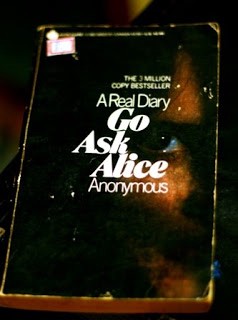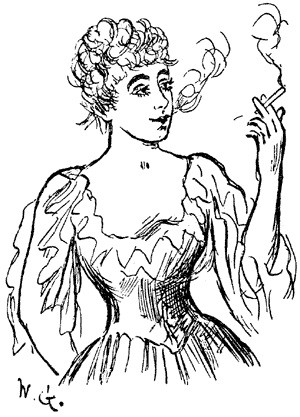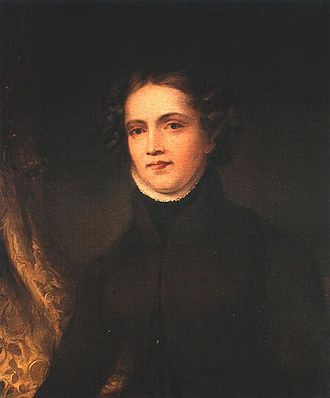Go Read Alice: The History of the Diary Novel
by Johannah King-Slutzky

Recently I was thinking about books from my childhood like Go Ask Alice, Harriet the Spy, and Dracula. In retrospect, these books made outlandish claims to authenticity, but I bought them literally and figuratively because they included supposedly non-fictional diary pages. As a kid, books like Go Ask Alice seem like a curio, but it turns out they belong to a multi-century line of diary novels for girls that awkwardly straddle patriarchy and feminism.
Diary novels are a product of the Victorian era, with their own fully stocked canon and historically specific conventions; it’s an under-attended but significant genre. Most early diary novels were written by clergy who didn’t actually read girls’ diaries: the diary novel developed under a tradition of older, usually religious people condemning diaries while also taking advantage of their cultural cachet. The irony of more contemporary diary novels like Go Ask Alice is this: ostensibly progressive, fun-loving diary novels feature a girl’s voice but are often bent on silencing women or at least quelling experimentation, while explicitly conservative diaries by women (real and fictive) must also justify why a woman was ostentatious enough to write and publish in the first place.
“Diary novel” is a term coined by scholar Gerald Prince, and they’ve been so criminally understudied that we didn’t identify them as a genre until his 1989 essay, but they’re cross-cultural and about as old as the epistolary novel. The modern canon of diary novels include Hjalmar Söderberg’s Doctor Glas (Swedish), Evan S. Connell’s The Diary of a Rapist (American), Doris Lessing’s The Golden Notebook (British), Jean-Paul Sartre’s Nausea (French), Ivan Turgenev’s The Diary of a Superfluous Man (Russian), and Junichiro Tanizaki’s The Key (Japanese). You’ll also find snippets of fictive diaries in books like Dracula and Robinson Crusoe.
Prince identifies three key features of the diary novel: besides having structured plot, (1) the narrator must be first-person, (2) the mode of narration is intercalated (Gérard Genette’s term; it means the narrative is fragmented, with events that occur since the previous entry), and (3) the intended audience is also the writer. Valerie Raoul has added an additional condition, that the diary novel begins in medias res. None of the three elements is a full definition of the diary novel, but Prince’s last criterion is particularly scurrilous, since the narrators of many diary novels (like The Journal of Salavin) explicitly assume among their potential readers spouses, parents, coworkers, and supervisors. The insistence that diaries be private is an invention of the 20th century. To solve these problems, Prince specifies further: the defining element of the diary novel is the theme of writing in a diary. All diary novels identify themselves as diaries with specific questions like, Why have I begun keeping a diary? or How, materially, is this diary being written? This is why so many diary novels feature winking publisher prefaces or ironic nods to the diary-novel’s constructedness, like Diary of a Nobody, whose eponymous “author” is a nobody both in terms of his small stature and real-world nonexistence.

Illustration from Diary of a Nobody. “I did not like the way she kept giggling and giving Lupin smacks and pinching him.”The diary novel canon is composed first of diary novels which have received significant (male) literary praise. But within this genre, the diary novel for women is an important and under-recognized sub-genre. These novels are usually evaluated on their historical merits because aesthetically, they are terrible: written by religious conservatives and/or befuddled men, often intended (in the Victorian era) to instruct. (French theorist Philippe Lejeune calls these “diaries of moral order,” Peter Abbott identifies “the Puritan diary”: these were often promoted in the early 1800s as pedagogical tools for schoolboys.) Of course, the instruction was lacquered on especially thick when the diary novel was published for women.
How is it that the same people who condemn diaries as “unwholesome, a genre that is usually chosen by people who can’t write anything else” (Ernest Renan), “worthless” (Maurice Blanchot), “perversions…orgies of secret literature” (George Duhamel), and “soft” (Béatrice Didier) could also publish diaries and diary novels? For almost as long as diaries have existed — about 400 years — women have had a powerful and controversial relationship with them. Summarizing the work of feminists like Valerie Sanders and Linda Peterson, Catherine Delafield argues that diaries are associated with women because they share domestic and quotidian connotations. Diaries emerged out of a tradition of family records, which women wrote uncontroversially. Diaries are also one of the few places women could write without bucking the expectation that women remain quiet.
Some critics trace the diary novel back to 1669 with the publication of The Portuguese Letters, an epistolary novel marketed as authentic correspondence. The wildly popular book consists of five letters from “Mariane,” a young woman in a convent writing to her ex with whom she is still painfully in love. The epistolary genre is at least as old as Ovid, but The Portuguese Letters may be the world’s earliest diary novel because of these two features: first, we see only Mariane’s side of correspondence; and second, because she is horny in a convent, Mariane spends most of her time in her own head, the effect of which is “a subjectivity thrown back almost entirely on its own resources” (H. Porter Abbott). But not everyone buys this argument. Valerie Raoul delays the first diary novel 150 years with the publication of Madame de Krüdener’s Valérie, published in 1803.
Many diary novels take their cues from nonfiction “moral order” diaries, which both pre-date and were regenerated by Romantic expressiveness. Two such examples are Pamela and its sequel Clarissa, both iconic 18th century epistolary novels by Samuel Richardson. Here, as with The Portuguese Letters, the epistolary novel/diary novel distinction is fuzzy, just as the relationship between IRL letters and early diaries blurs depending on how many dates and addressees you include in your letters. In this case, the journal/letter distinction is particularly challenging because Pamela writes letters she won’t send; the fallacious “editor” of the book says she keeps her letters “journal-wise.”
Anxiety about sex and gender roles is all over these novels. Here’s Wikipedia’s summary:
[Mr. B.] abducts [Pamela], locks her up in one of his estates, and attempts to seduce and rape her. She rejects him continually, but starts to realise that she is falling in love with him. He intercepts her letters to her parents; reading them, he becomes even more enamored by her innocence, intelligence, and continuous escape attempts. Her virtue is eventually rewarded when he sincerely proposes an equitable marriage to her.
H. Porter Abbott notes the parallels between Pamela/Clarissa and a Puritan diary: the letters are to be read instructionally, characters are “awakened” and “converted,” and Pamela’s diction mixes accounting and liturgical metaphors, as when she vows to keep her journal “quarter to quarter; and a general balance at every year’s end. — And I have written in it, Humble RETURNS for DIVINE MERCIES” (emphasis Richardson’s).
Somehow, even moralizing fiction like Pamela was condemned as titillating. This is typical of the genre, a large number of which feature rape as simultaneously moral and pornographic devices. If you’re worried about the immortality of your soul, a safer bet is Madmoselle Monniot’s Marguerite’s Journal (1858), an influential diary novel about a girl’s life between ages 10 and 12, in which she takes her First Communion and withstands the deaths of her father, brother, and best friend. In the novel’s sequel, Marguerite enters a convent. Marguerite was read widely by school girls until World War I. The popularity of these novels demonstrates that (1) diaries provoke anxiety in moral zealots, particularly on the topics of sex and vanity and (2) diaries real and fictive are an ideal site to fight for girls’ propriety.
Moral order diaries, crucially, escape the criticism of being vain. But why is the diary vain in the first place? Historians identify four traditions that influenced the practice of diaries: business accounting, family records, travel itineraries, and spiritual diaries. These traditions were public or semi-public, and never expressive. Letter-writing, which is more intimate, is also an important forerunner to the diary: in Isaac D’Israeli’s words, “We converse with the absent by letters, and with ourselves by diaries.” (D’Israeli, who wrote his essay on diaries in 1793, believed only some topics deserved to be journaled about; for example, one should never diarize one’s dreams.) The terms “journal” and “diary, ”which I am using interchangeably, didn’t even apply to personal writing until Francis Bacon’s 1605 Advancement of Learning, and even Bacon suggested only great events should be committed to paper. And the older and more expressive genre of memoir, like Augustine’s Confessions, rarely factors into academics’ study of diary: memoir does not begin in medias res and is not intercalated (broken up by dates).
An important forerunner to the Victorian moral order diary was the spiritual diary, a self-monitoring tools popular among votaries. The earliest known spiritual diary belongs to Saint Anthony in the fourth century, who wrote his sins down to prepare for confession. The tradition continued into the 1800s, when it was secularized and adopted as a moral aid for schoolboys. Some journals, like Anthony’s, were repressive; others, mystical. Unlike the modern journal, none were analytic. For example, Philippe Lejeune describes Ignatius of Loyola’s diary as a “spiritual weather report” and a list of sins with checkmark boxes next to each item. The column form was common well into the 19th century. The novel Cranford, written in 1853 but taking place 60 years prior, features a diary whose diegetic author “Miss Matty” describes as a kind of accounting: “[W]e were to put down in the morning what we thought would be the course and events of the coming day, and at night we were to put down on the other side what really happened.”
Despite their paucity of expression, even spiritual journals were sometimes considered vain. This was the attitude of Pierre de Saint-Roumald, whose 17th century guidebook advises, “Tell no one of the favors that you receive from God, for, apart from the fact that it is stupid and vain, you also run the risk of losing your devotion entirely.” Those who did advocate for spiritual journals generally did so with the goal either of re-reading for self-instruction or complete detachment of self.
But diaries changed suddenly in the 19th century. For one thing, diaries became popular outside spiritual or administrative contexts. The first diary published in English was John Evelyn’s in 1818, closely followed by that of the more famous Samuel Pepys in 1825. Most diaries were published by relatives after the author’s death. Their intention, like that of many spiritual diaries, was to instruct the living: a case that was particularly important for the diaries of women. The first woman’s diary published in English was Frances Burney’s (1842–6), although women had been keeping unpublished diaries since at least 1783. Published diaries frequently consisted of “rules for living,” with few particulars and little originality. The best women’s diaries were often purchased for for specialty religious markets.
Real women’s diaries were rarely published unless their author was famous or related to someone famous, and even those were decidedly moralizing. Perhaps the most consistently cited of these is the diary of Eugénie de Guérin, sister of poet Maurice de Guérin. But on the other hand there’s Frances Burney, It-Girl novelist, whose diaries were published between 1842 and 1846 on the basis of Burney’s own fame. Unlike earlier ledger-keepers, Burney personifies her journals. She addresses her diary “To NOBODY…since to Nobody can I be wholly unreserved” (27 March 1768) and later addresses particular entries to Samuel “Daddy” Crisp, sisters Susan and Charlotte, and friend Frederica Locke. Aside from personification, however, the journals are far from modern: they still resemble business documents. When she upbraids herself, Burney uses diction like “minutes,” “accounts,” and “memorandums.” The editor’s introduction, written by Burney’s niece, Charlotte Barrett, notes that Burney’s journals are titillating — remember, Burney was famous — but emphasizes that good female readers will treat them as instructive: “We would also hope there may be a moral use in presenting the example of one who, being early exalted to fame and literary distinction, yet found her chief happiness in the discharge of domestic duties, and it the friendships and attachments of private life.”
A more common practice was the total falsification of women’s journals, also for instructional purposes, often at the hand of men. Ironically, authentic and inauthentic journals didn’t radically differ. For example, although in 1841 Louise Ancelot noted that diaries were the latest fashion among her adolescent classmates, Philippe Lejeune has found few mentions in diaries from the mid 19th century of puberty or sexuality. Women were complicit in their own self-censorship. Burney actually burned many of her more incriminating letters (a common practice at the time) and edited her diaries for publication by adding text for narrative flow, cutting out anything too personal, offensive, or trivial, correcting grammar, and occasionally adding symbols. She also cut one diary-book out completely from the year her brother was arrested.
But as always, self-censorship was not universal. For example, the diaries of Anne Lister, which she wrote from 1806–1840 (published 1988), make open reference to Lister’s lesbianism, although the diaries were sometimes written in a code she shared only with select lovers. “O women, women!” opines Lister in 1824 after reading a married ex’s name in her own diary-index. She does not equivocate. On 29 January 1821: “I love, & only love, the fairer sex & thus beloved by them in turn, my heart revolts from any love than theirs.” Or on religious shame: “Who will be the next tenant of my heart? Providence orders all things wisely.” (31 December 1832). I like to believe that Lister, who preferred to wear all-black, stuffed her chest to achieve a more “striking” look, and sometimes went by “Gentleman Jack,” would welcome all of us readers into the residence of her heart.

Portrait of Anne Lister by Joshua HornerThe Romantics bear significant responsibility for self-expression in journals. Dorothy Wordsworth (sister to William), Sir Walter Scott, and Lord Byron all kept diaries. Henri-Frédéric Amiel is one of the most influential of the 19th century’s published diarists, often cited for cementing the expressive diary form most people consider transhistorical today. (The French call this type of diary journaux intimes, or private journals: for reasons I don’t understand this perfectly legible term is never translated by academics into English.) Amiel’s highly introspective journals famously influenced Nobel Prize winner and fellow diarist André Gide, whose early work is sometimes considered a lite version of the Romantic Johann Wolfgang von Goethe. Even woman-diarists were affected by the Romantics! One such diarist was Marie-Edmée Pau, whose popular diaries were marketed as religious documents (gotta get that SEO) but contain a more Romantic flair. Here is Marie-Edmée at 18:
I shall go abroad and lead a bohemian life, I shall become an artist…What I need is space and freedom: what I need is an independent life whose responsibility rests with myself alone…in order to find strength in my own will. How inconvenient to be a woman for such great schemes! (1 May 1863).
19th century expressiveness was new, cool, and dangerous. Diary novels respond to this crisis, safely containing women’s expression through melodrama and awkward moralizing, as any reader of Go Ask Alice will recognize.
But subversion, too, is possible. Deferring again to the example of Marie-Edmée’s diary, you can see it’s not too hard to get away with monkey business even when diaries are marketed as religious artifacts. But also, not all moralizing is antifeminist. Many diary novels feature the rape of women from women’s perspectives — not necessarily a bad thing. One such diary novel is Anne Brontë’s The Tenant of Wildfell Hall (1848), an instant success whose pages include fictional diarist Helen Graham’s discussions of her abusive husband’s alcoholism.
Horror is fertile ground for the parody of religious diaries and diary novels. Trevor Field has noted that many novel diaries fixate on sudden personality changes. Here is Field on one such diary novel, Peter Tonkin’s 1981 The Journal of Edwin Underhill:
The difference between the two parts (journal and nocturnal) is emphasized by a differentiation of character as the narrator becomes associated with ‘the Dead’, an evil spirit from the sixteenth century. The character who is now described as having long brindled hair, almond-shaped eyes, blood-red eyeballs and various other characteristics of literary vampires is for some reason referred to quite consistently as ‘I, Edwin Underhill’, with the simple name Underhill being reserved for the person who succumbed to gas fumes at the end of Part I.
The same trope is present, in truncated form, in Bram Stoker’s Dracula, whose Mina Harker slips between telepathic and semi-conscious states after she is bit by the famous Transylvanian. Throughout it all Mina keeps a journal that Stoker collages into the novel. A third famous example is Charlotte Perkins Gilman’s short story “The Yellow Wallpaper,” a series of diary entries that chart Jane’s descent into madness. Psychological and supernatural horror are perversions of the religious diary’s emphasis on conversion; like Pamela’s rapist husband or Marguerite at a nunnery, Jane and Mina are converted, too: one, to insanity, the other, near-vampirism.
Diary novels may be the man’s way of having his cake and eating it, too. But not all is lost: whether encountering girls’ journals in Harriet the Spy or Go Ask Alice, this seemingly haphazard hybrid genre is old enough to have learned a couple of tricks. With time, maybe it’ll figure out a few more.
Previously: A History of Women Whose Tongues Have Been Ripped Out
Johannah King-Slutzky is a freelance blogger and essayist. She tweets @jjjjjjjjohannah.